Greenway Implementation Influence on Agricultural Heritage Sites (AHS): The Case of Liantang Village of Zengcheng District, Guangzhou City, China
Abstract
:1. Introduction
1.1. Literature Review
1.2. Research Aim
2. Study Area
2.1. Zengcheng District and its Lychee and Black Olive Cultures
2.2. Liantang Village
- (1)
- Liantang Village has long been the planting region for black olive and lychee, which are famous agricultural products of southern China. At present, more than 1800 large old trees (80% of them are black olive trees) have been around for over 100 years, and Liantang is home to the largest old tree cluster in Guangzhou. These valuable points of agricultural heritage have become the most important tourism resources in Liantang Spring.
- (2)
- Liantang Spring is a segment of the Zeng River greenway system which is the earliest recreational rural greenway in China. Since the greenway was implemented in September 2008, Liantang Spring has been rapidly developed into a famous rural tourist destination (Figure 2). Liantang Village is the core area of Liantang Spring and is the tourist service center where most tourism resources and reception facilities are mainly distributed [29]. Thus, villagers often express, “no greenway, no Liantang Spring” to emphasize the role of greenway in Liantang. Statistics show that Liantang received 0.5 million tourists in 2016.
3. Material and Methods
4. Results
4.1. Economic Influence
4.2. Social Influence
4.3. Effect on the Conservation of Agricultural Heritage
5. Discussion
5.1. The Greenway as an Approach for AHS Sustainability
5.2. Strategies for Greenway Sustainable Use and Heritage Conservation
6. Conclusions
Acknowledgments
Author Contributions
Conflicts of Interest
References
- Lindsey, G. Use of urban greenways: Insights from Indianapolis. Landsc. Urban Plan. 1999, 45, 145–157. [Google Scholar] [CrossRef]
- Fábos, G.J.; Ryan, R.L. An introduction to greenway planning around the world. Landsc. Urban Plan. 2006, 76, 1–6. [Google Scholar] [CrossRef]
- Little, C. Greenways for American; Johns Hopkins University Press: Baltimore, MD, USA, 1990. [Google Scholar]
- Yu, K.; Li, D.; Li, N. The evolution of greenways in China. Landsc. Urban Plan. 2006, 76, 223–239. [Google Scholar] [CrossRef]
- Siderelis, C.; Moore, R. Outdoor recreation net benefits of rail-trails. J. Leisure Res. 1995, 27, 344–359. [Google Scholar] [CrossRef]
- Nicholls, S.; Crompton, J.L. The impact of greenways on property values: Evidence from Austin, Texas. J. Leisure Res. 2005, 37, 321–341. [Google Scholar] [CrossRef]
- Pettengill, P.R.; Lee, B.H.Y.; Manning, R.E. Traveler perspectives of greenway quality in northern New England. Transp. Res. Rec. 2012, 2314, 31–40. [Google Scholar] [CrossRef]
- Lumsdon, L.; Downward, P.; Cope, A. Monitoring of cycle tourism on long distance trails: The North Sea Cycle Route. J. Transp. Geogr. 2004, 12, 13–22. [Google Scholar] [CrossRef]
- Palau, R.; Forgas, S.; Blasco, D.; Ferrer, B. An analysis of greenways from an economic perspective. Tour. Plan. Dev. 2012, 9, 15–24. [Google Scholar] [CrossRef]
- Deenihan, G.; Caulfield, B.; O’Dwyer, D. Measuring the success of the Great Western Greenway in Ireland. Tour. Manag. Perspect. 2013, 7, 73–82. [Google Scholar] [CrossRef]
- Burel, F.; Baudry, J. Social, aesthetic and ecological aspects of hedgerows in rural landscapes as a framework for greenways. Landsc. Urban Plan. 1995, 33, 327–340. [Google Scholar] [CrossRef]
- Peterson, A.; Gyllin, M.; Haaland, C.; Larsson, A. Recreation in Swedish agricultural areas: Public attitudes to multifunctional greenway designs. In Fábos Conference on Landscape and Greenway Planning; Fábos, J.G., Ed.; Corvinus University of Budapest: Budapest, Hungary, 2010; pp. 503–509. [Google Scholar]
- Vafadari, K. Review: Planning sustainable tourism for agricultural heritage landscapes. Ritsumeikan J. Asia Pac. Stud. 2013, 32, 75–89. [Google Scholar]
- Tian, M.; Min, Q.; Tao, H.; Yuan, Z.; He, L.; Lun, F. Progress and prospects in tourism research on Agricultural Heritage Sites. J. Resour. Ecol. 2014, 5, 381–389. [Google Scholar]
- Min, Q.; Sun, Y.; Cheng, S.; Wang, X. Primary study on the features and development of GIAHS’s tourism resources. Econ. Geogr. 2007, 27, 856–859. (In Chinese) [Google Scholar]
- Sun, Y.; Min, Q.; Liu, M. Tourism resources utilization of different types of agricultural heritage systems. Resour. Sci. 2013, 35, 1526–1534. (In Chinese) [Google Scholar]
- Koohafkan, P.; Altieri, M.A. Forgotten Agricultural Heritage: Reconnecting Food Systems and Sustainable Development; Earthscan Food and Agriculture Series; Routeledge: London, UK, 2016. [Google Scholar]
- Zhang, Y.; Min, Q.; Li, H.; He, L.; Zhang, C.; Yang, L. A conservation approach of Globally Important Agricultural Heritage Systems (GIAHS): Improving traditional agricultural patterns and promoting scale-production. Sustainability 2017, 9, 295. [Google Scholar] [CrossRef]
- Min, Q.; Zhang, Y.; Jiao, W.; Sun, X. Responding to common questions on the conservation of agricultural heritage systems in China. J. Geogr. Sci. 2016, 26, 969–982. [Google Scholar] [CrossRef]
- Sun, Y. Research review on agricultural heritage systems and its tourism development. J. Landsc. Res. 2012, 4, 54–58. [Google Scholar]
- Busby, G.; Rendle, S. The transition from tourism on farms to farm tourism. Tour. Manag. 2000, 21, 635–642. [Google Scholar] [CrossRef]
- Vafadari, K. Exploring tourism potential of Agricultural Heritage Systems: A case study of the Kunisaki Peninsula, Oita Prefecture, Japan. Issues Soc. Sci. 2013, 1, 33–52. [Google Scholar] [CrossRef]
- Zhao, F.; Wu, Z. Research on agricultural heritage tourism planning: A case study of Zengcheng Simiao rice. Agric. Archaeol. 2011, 4, 385–388. (In Chinese) [Google Scholar]
- Chen, C.F.; Chen, P.C. Resident attitudes toward heritage tourism development. Tour. Geogr. 2010, 12, 525–545. [Google Scholar] [CrossRef]
- Sun, Y.; Wang, J.; Liu, M. Community perspective to agricultural heritage conservation and tourism development. J. Resour. Ecol. 2013, 4, 258–266. [Google Scholar]
- Yoon, Y.; Gursoy, D.; Chen, J.S. Validating a tourism development theory with structural equation modeling. Tour. Manag. 2001, 22, 363–372. [Google Scholar] [CrossRef]
- Zhao, F. Kua Lu Lychee in Zengcheng District: Its History and Culture; China Agriculture Press: Beijing, China, 2015. (In Chinese) [Google Scholar]
- Zhao, F.; Ni, G.; Zhang, J. Research on plantation and utilization of the black olive in historical period of Zengcheng. Agric. Archaeol. 2014, 1, 216–221. (In Chinese) [Google Scholar]
- Zhao, F.; Gong, J.; Li, Y. Research on the recreational greenway user’s behavior and experience satisfaction in rural areas. Areal Res. Dev. 2016, 35, 110–114. (In Chinese) [Google Scholar]
- Rasoolimanesh, S.M.; Ringle, C.M.; Jaafar, M.; Ramayah, T. Urban vs. rural destinations: Residents’ perceptions, community participation and support for tourism development. Tour. Manag. 2017, 60, 147–158. [Google Scholar] [CrossRef]
- Byrd, E.T. Stakeholders in sustainable tourism development and their roles: Applying stakeholder theory to sustainable tourism development. Tour. Rev. 2007, 62, 6–13. [Google Scholar] [CrossRef]
- Sharpley, R. Host perceptions of tourism: A review of the research. Tour. Manag. 2014, 42, 37–49. [Google Scholar] [CrossRef]
- Palmisano, G.O.; Govindan, K.; Loisi, R.V.; Sasso, P.D.; Roma, R. Greenways for rural sustainable development. Land Use Policy 2016, 50, 429–440. [Google Scholar] [CrossRef]
- Mundet, L.; Coenders, G. Greenways: A sustainable leisure experience concept for both communities and tourists. J. Sustain. Tour. 2010, 18, 657–674. [Google Scholar] [CrossRef]
- Wu, C.J.; Isaksson, K.; Antonson, H. The struggle to achieve holistic landscape planning: Lessons from planning the E6 Road Route through Tanum World Heritage Site, Sweden. Land Use Policy 2017, 67, 167–177. [Google Scholar] [CrossRef]
- Carvalho-Ribeiro, S.; Pinto Correia, T.; Paracchini, M.L.; Schüpbach, B.; Sange, O.A.; Vanderheyden, V.; Southern, A.; Jones, P.; Contreras, B.; O’Riordan, T. Assessing the ability of rural agrarian areas to provide cultural ecosystem services (CES): A multi scale social indicator framework (MSIF). Land Use Policy 2016, 53, 8–19. [Google Scholar] [CrossRef]
- Milcu, A.I.; Hanspach, J.; Abson, D.; Fischer, J. Cultural ecosystem services: A literature review and prospects for future research. Ecol. Soc. 2013, 18, 44. [Google Scholar] [CrossRef]
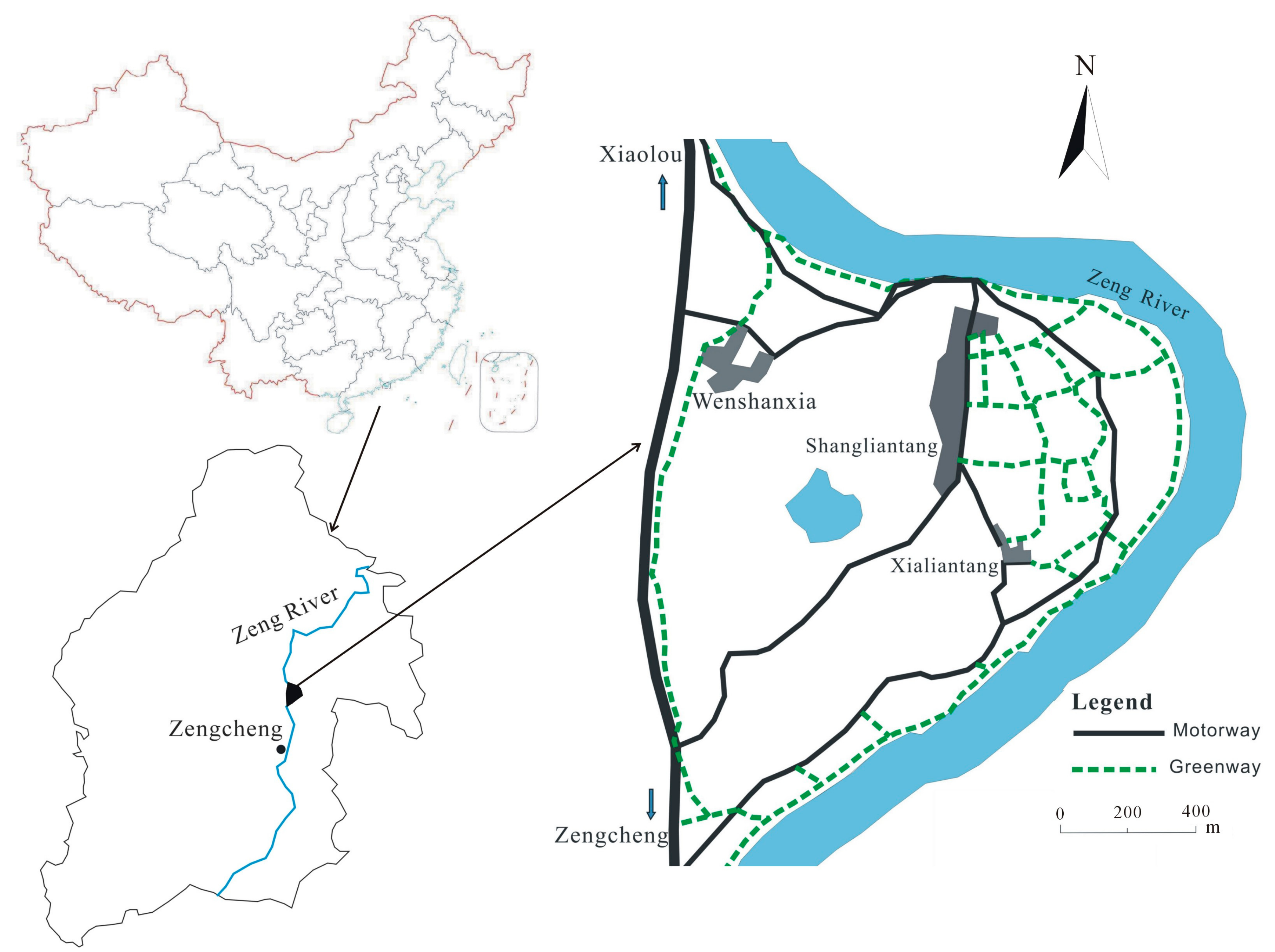

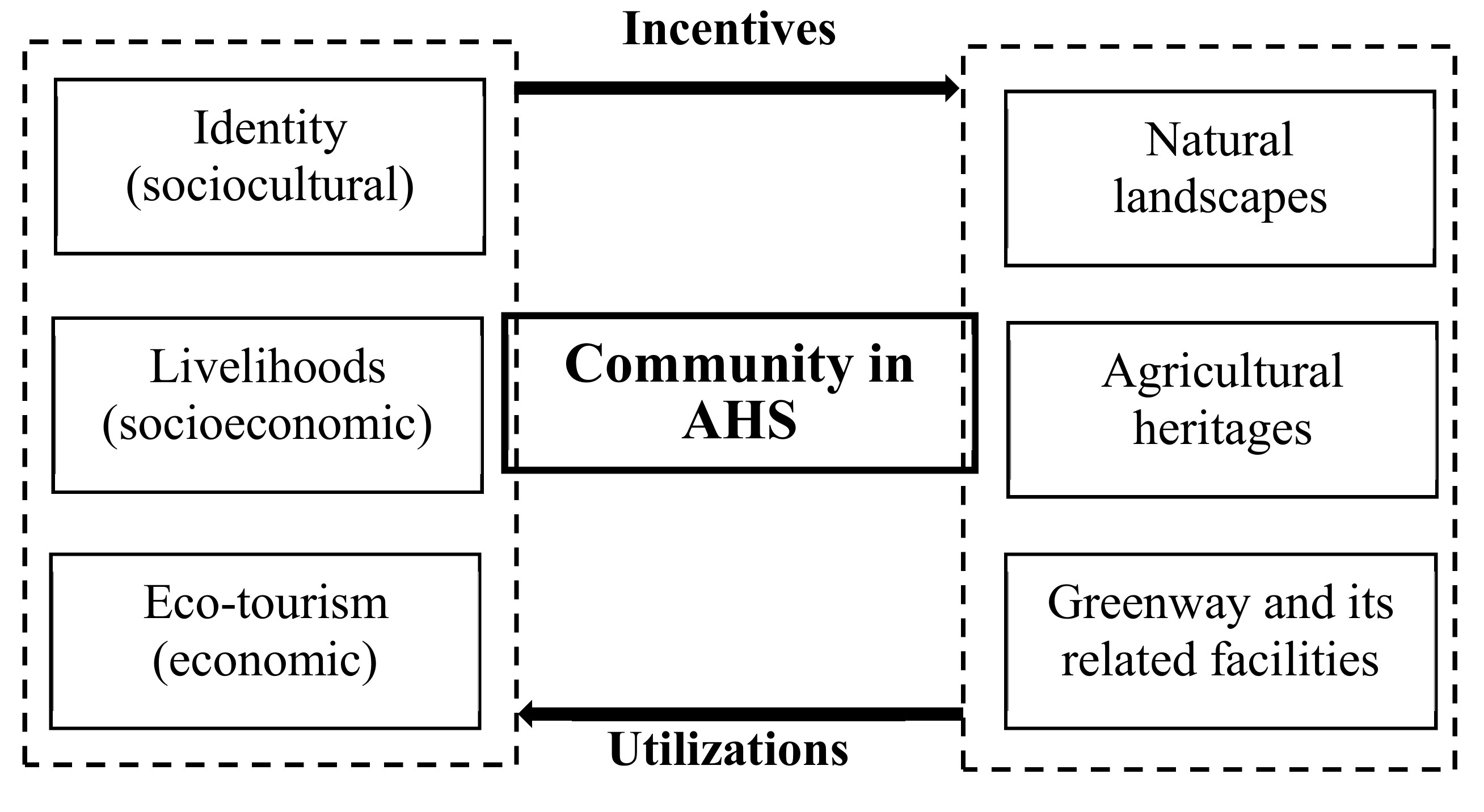
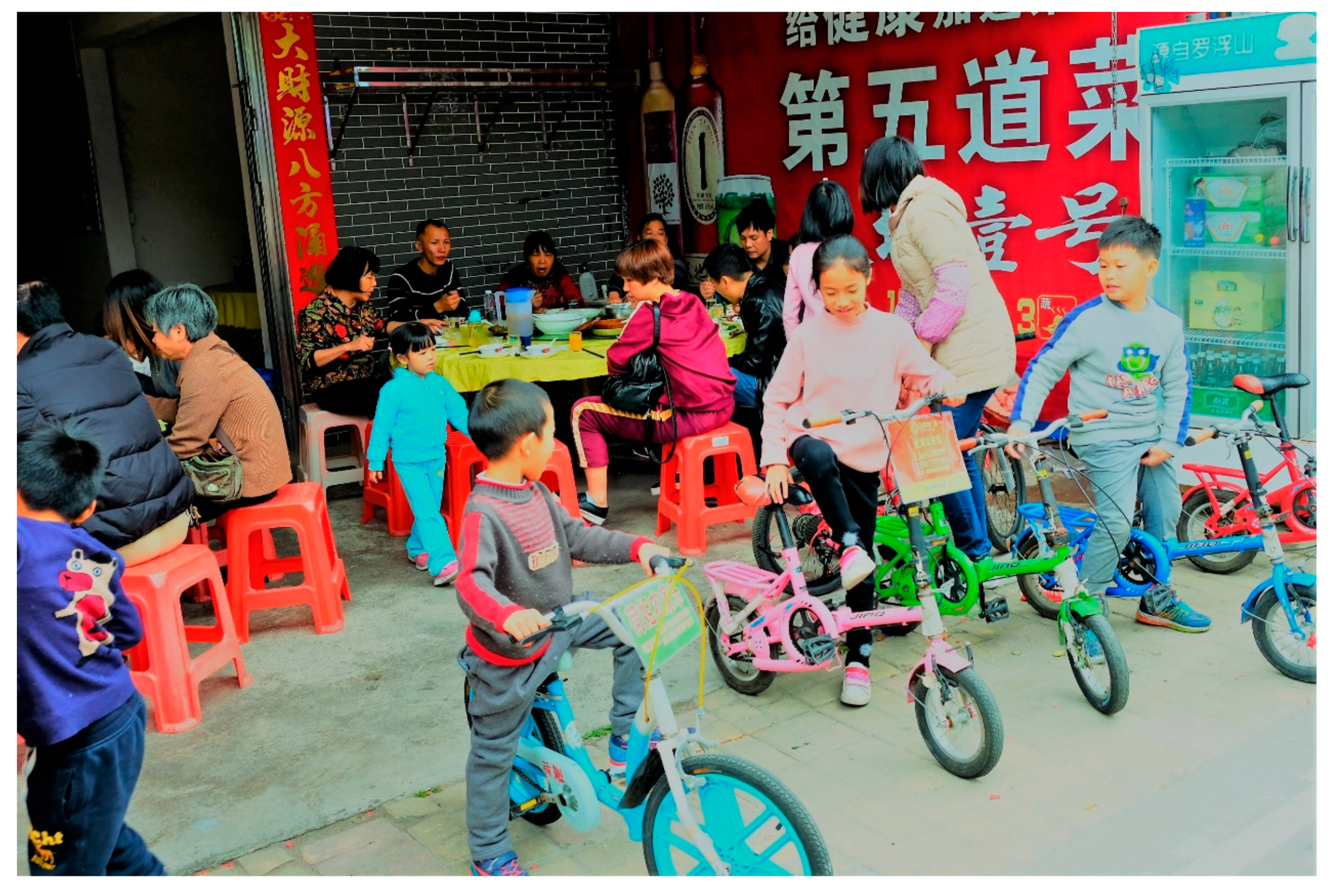
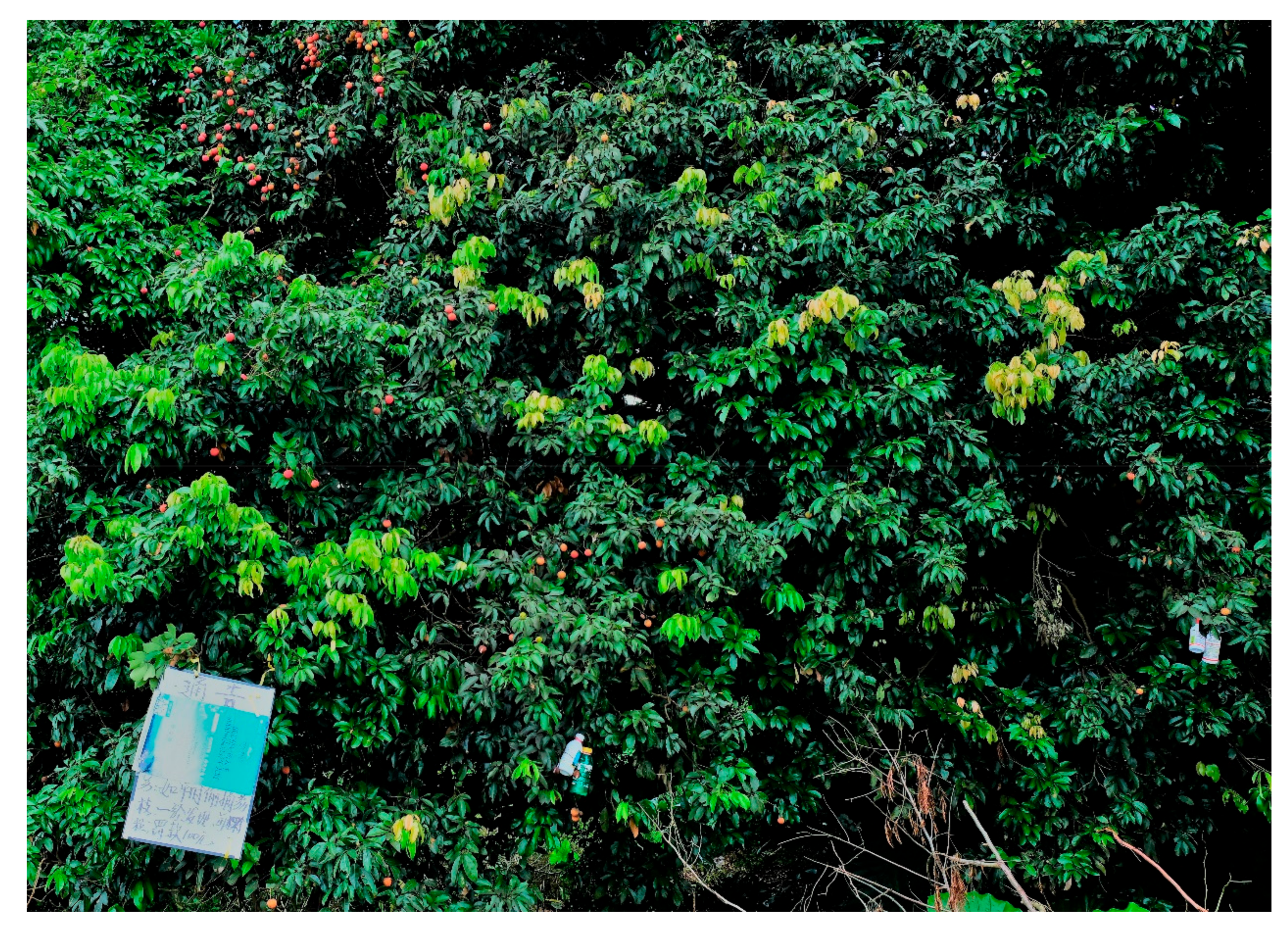
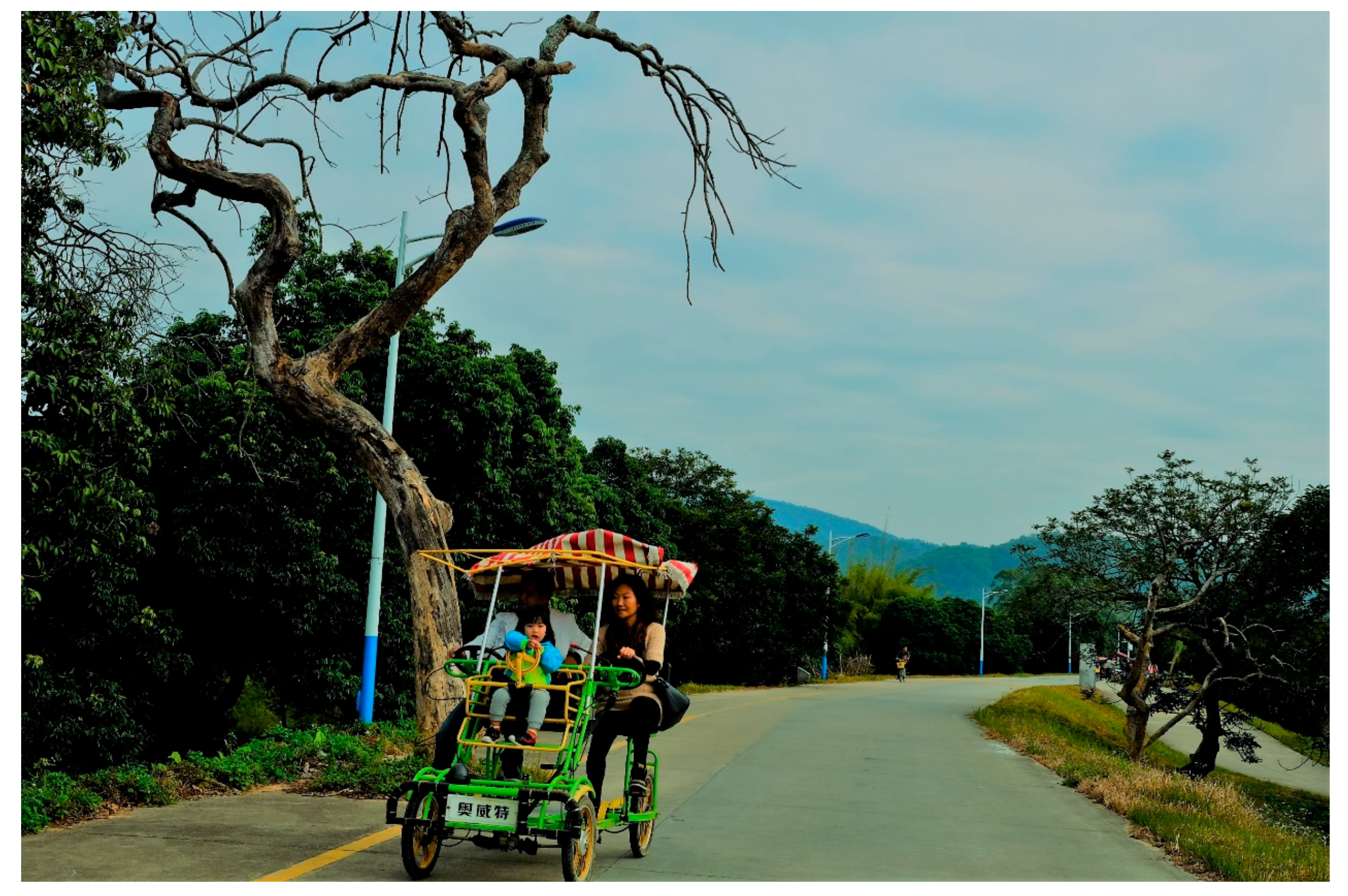
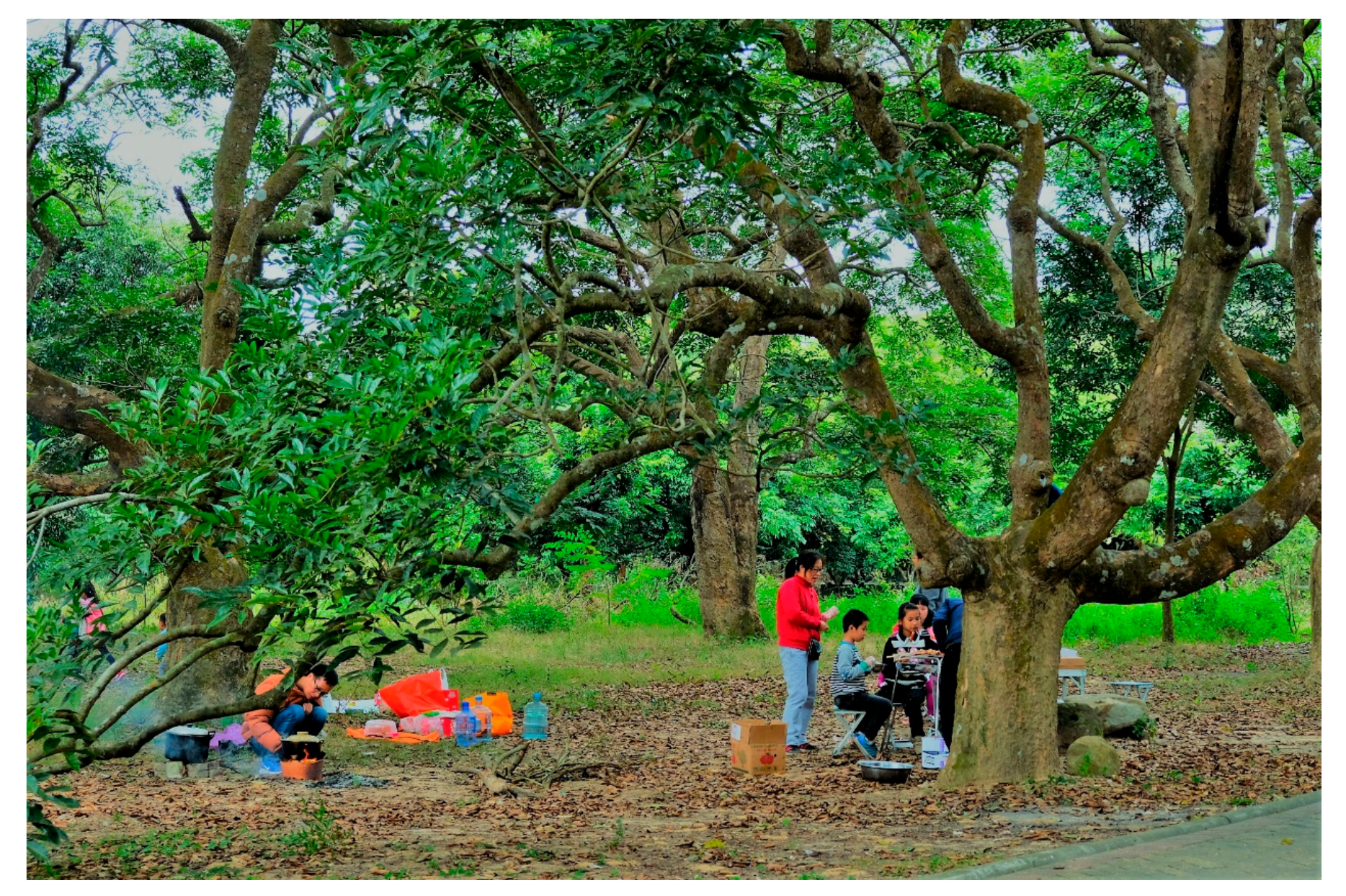
| Types of Business Sites | Number and Location of Business Sites | Remark |
|---|---|---|
| Agritainment | 22 agritainments in Shangliantang; 8 in Xialiantang. | All sites provide catering and bike rental services; 14 sites provide accommodation and join a chain hotel, namely, Wanjia Cottage |
| Store | 6 stores in Shangliantang, one is fishing tackle shop; one in Xialiantang | The goods on sale are articles for daily use. The fishing tackle shop provides convenience for tourists to go fishing in Zeng River |
| Sales point of agricultural products | 2 shops and 10 temporary building points in Shangliantang; 2 temporary building points in Xialiantang | The goods sold vary with the season, mainly include salted products of black olive, dried lychee and longan, tofu curd, peanut oil, sweet potato, dried fish, and vegetables |
| Others | 2 financial service stations, 1 electric sightseeing motorcycle club in Shangliantang; 1 agricultural park | In 2014, Liantang rented a 10.7 ha farmland to Yuefeng Company as an agricultural park for growing grapes and pitaya |
| Number | Variable | Mean | S.D. | Approval Rate (%) | ||
|---|---|---|---|---|---|---|
| Bystander | Stakeholder | Undetermined | ||||
| A1 | Greenway has led to the rapid development of tourism. | 4.29 | 0.773 | 84.9 | 93.3 | 89.6 |
| A2 | Tourism has brought more and better public services than before. | 4.04 | 0.925 | 78.8 | 81.4 | 79.2 |
| A3 | My income has increased significantly. | 3.82 | 0.947 | 54.6 | 86.4 | 70.9 |
| A4 | Tourism has created job opportunities, especially for women. | 3.74 | 0.977 | 54.5 | 83.0 | 60.5 |
| A5 | The number of migrant workers has decreased. | 3.57 | 0.915 | 57.6 | 67.8 | 60.4 |
| A6 | Tourism has led to price inflation. | 3.16 | 1.123 | 35.4 | 62.7 | 70.8 |
| Number | Variable | Mean | S.D. | Approval Rate (%) | ||
|---|---|---|---|---|---|---|
| Bystander | Stakeholder | Undetermined | ||||
| B1 | Tourism has improved my living conditions. | 3.75 | 0.983 | 57.6 | 76.3 | 73.0 |
| B2 | My personal quality of life is enhanced. | 3.86 | 0.751 | 84.9 | 77.9 | 75.0 |
| B3 | My personal hygiene is improved. | 3.87 | 0.896 | 78.8 | 74.6 | 77.1 |
| B4 | People speak Mandarin. | 3.55 | 0.984 | 60.6 | 66.1 | 62.5 |
| B5 | More outsiders come here to work. | 3.46 | 1.069 | 45.4 | 62.7 | 70.8 |
| B6 | More outsiders come to do business. | 3.73 | 0.936 | 63.7 | 77.9 | 64.6 |
| B7 | The number of villagers engaged in agriculture decreased. | 3.69 | 0.864 | 66.7 | 76.3 | 70.8 |
| B8 | My routine of life and work are disturbed. | 3.90 | 0.867 | 87.9 | 66.1 | 77.1 |
| B9 | Security situation deteriorated. | 3.21 | 1.085 | 54.6 | 44.1 | 43.7 |
| Number | Variable | Mean | S.D. | Approval Rate (%) | ||
|---|---|---|---|---|---|---|
| Bystander | Stakeholder | Undetermined | ||||
| C1 | Old trees are precious heritages and must be protected carefully. | 4.19 | 0.745 | 90.9 | 94.9 | 81.3 |
| C2 | The landscape of old trees is an important element to attract tourists. | 3.89 | 0.793 | 81.9 | 77.9 | 75.0 |
| C3 | Tourists like the lychee, black olive, and other local agricultural products. | 4.27 | 0.610 | 90.7 | 98.3 | 91.7 |
| C4 | The number of tourists increase considerably during the picking season of lychee and black olive. | 4.00 | 0.814 | 78.9 | 86.4 | 83.3 |
| C5 | Economic benefits of lychee and black olive have greatly improved. | 3.89 | 0.759 | 75.8 | 84.7 | 70.8 |
| C6 | I had a clearer cognition for the value of old trees than before. | 3.86 | 0.819 | 75.8 | 81.3 | 75.0 |
| C7 | I have raised awareness of old trees protection. | 3.94 | 0.722 | 84.9 | 81.3 | 68.7 |
| C8 | The management of old trees has been strengthened. | 3.94 | 0.712 | 90.9 | 79.6 | 73.0 |
| C9 | The number of old trees felled declined. | 3.86 | 0.861 | 81.8 | 76.3 | 64.6 |
| C10 | The government should promote the declaration of China-Nationally Important Agricultural Heritage Systems. | 4.04 | 0.714 | 66.8 | 86.4 | 75.0 |
| C11 | I should actively support and participate in the protection of old trees. | 4.12 | 0.629 | 78.8 | 93.2 | 85.4 |
| C12 | Protection of old trees is conducive to greenway tourism development. | 4.02 | 0.605 | 78.8 | 89.8 | 85.4 |
© 2018 by the authors. Licensee MDPI, Basel, Switzerland. This article is an open access article distributed under the terms and conditions of the Creative Commons Attribution (CC BY) license (http://creativecommons.org/licenses/by/4.0/).
Share and Cite
Zhao, F.; Nie, R.; Zhang, J. Greenway Implementation Influence on Agricultural Heritage Sites (AHS): The Case of Liantang Village of Zengcheng District, Guangzhou City, China. Sustainability 2018, 10, 434. https://doi.org/10.3390/su10020434
Zhao F, Nie R, Zhang J. Greenway Implementation Influence on Agricultural Heritage Sites (AHS): The Case of Liantang Village of Zengcheng District, Guangzhou City, China. Sustainability. 2018; 10(2):434. https://doi.org/10.3390/su10020434
Chicago/Turabian StyleZhao, Fei, Rui Nie, and Jia’en Zhang. 2018. "Greenway Implementation Influence on Agricultural Heritage Sites (AHS): The Case of Liantang Village of Zengcheng District, Guangzhou City, China" Sustainability 10, no. 2: 434. https://doi.org/10.3390/su10020434





